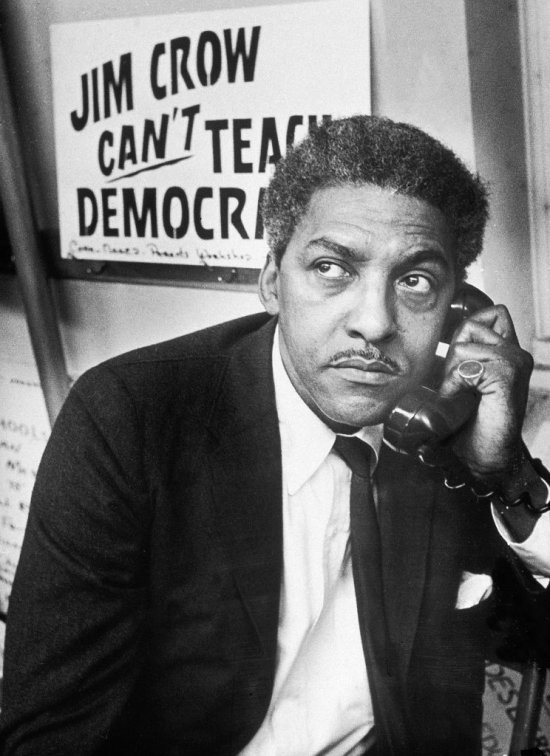
As the movie 'Rustin' comes out in theaters and starts streaming on Netflix, here's what to know about Bayard Rustin's life and legacy
This year marked the 60th anniversary of Martin Luther King, Jr.’s “I Have a Dream” speech at the March on Washington for Jobs and Freedom (“March on Washington” for short) on Aug. 28, 1963. And yet, Bayard Rustin, the maestro behind the planning of the March on Washington, is still not a household name 60 years later. A new movie plans to change that. Rustin, out in select theaters Nov. 3 and on Netflix Nov. 17 is about how the civil rights leader planned a march in support of a movement that didn’t always support him as an openly gay Black man.
[time-brightcove not-tgx=”true”]Born in 1912 in West Chester, Pennsylvania, Rustin grew up in a Quaker family, which inspired him to become an activist for economic justice, equal rights, and peace. A conscientious objector in World War II, he opted to go to federal penitentiary rather than serve in the war effort, ultimately boasting more than 20 arrests throughout his career. He became a go-to organizer of demonstrations, including a prayer pilgrimage for freedom in Washington that catapulted Dr. King onto a national stage and a youth march for integrated schools. He is often quoted as championing “creative trouble” or “angelic trouble.” As Rustin himself summed up his idea of the civil rights movement’s aims to Malcolm X in 1960, “I believe the great majority of the Negro people, black people, are not seeking anything from anyone. They are seeking to become full-fledged citizens.”
But King cut Rustin out of his inner circle in 1962 over concerns about Rustin being openly gay. Back then, homosexual or gay men were “considered to be criminals and mentally sick and sinners,” according to Michael Long, editor of the anthology, Bayard Rustin: A Legacy of Protest and Politics and More Than a Dream: The Radical March on Washington for Jobs and Freedom. “Civil rights leaders wanted to keep Rustin in the shadows so that they wouldn’t be tainted by his gay sexuality. It wasn’t just the civil rights leaders; Rustin himself, elected to remain in the shadows, was very aware of the problems that his gay sexuality posed in a homophobic society and the ways that it could create problems for the civil rights movement.”
With the civil rights movement’s voter rights and desegregation efforts floundering in the Albany, Georgia, area, King came calling, and Rustin, a very forgiving person, made up with him. In the end, King and Rustin complemented one another; King was the creative visionary and Rustin was the one who excelled at the logistics and the organizing, forming coalitions with other like-minded social movements.
Rustin’s crowning achievement was organizing the 1963 March on Washington for Jobs and Freedom. About 250,000 people streamed toward the Lincoln Memorial on Aug. 28, 1963, to voice their support for civil rights and equal employment opportunities. “Rustin, unlike anybody else in the civil rights movement, really pushed the movement to address economic issues—poverty, under-employment, unemployment,” says Long. “He understood that it was one thing to be able to sit in a desegregated restaurant. It was another thing to be able to buy the damn hamburger.” The demonstration helped galvanize momentum for the Civil Rights Act (1964) and Voting Rights Act (1965).
For the rest of his career, Rustin focused his activism on getting more Black people to run for office. “After the March on Washington, we see Black people running to become mayors, state legislators, federal legislators,” according to Long. As Rachelle Horowitz, a transportation coordinator for the March on Washington, explained the thinking behind that strategy to TIME for the march’s 50th anniversary in 2013, Rustin believed that “the struggle for freedom in the United States had to eventually move to Washington, D.C., that it had to move to the center of power, to where the President and the Congress were—that no matter how many demonstrations took place in Montgomery and in Birmingham and places all around the South, until you could change the central government and have it legislate for all of the country, significant things wouldn’t happen.”
Rustin lived out the rest of his days happily partnered to the artist and photographer Walter Naegle. He passed away on Aug. 24, 1987, at the age of 75, after complications from a ruptured appendix.
More than three decades later, Rustin’s story is not widely taught in K-12 schools in the U.S., but more resources on him have become available as awareness of LGBTQ+ identities have grown and amid a general push to make more African American history resources available on social media after the murder of George Floyd.
Rustin screenwriter Julian Breece told TIME that he was determined to give Rustin the big screen treatment because he didn’t want people to find out about Rustin in the haphazard way he learned about him.
“I found out about Bayard Rustin in high school, not because he was in textbooks or taught in school. I was just a millennial on the Internet, trying to find anything about the other Black gay men who were out there,” Breece says. “That’s why I think this movie is so important, not just for young queer people, but for anyone who feels different or anyone who feels like an outsider.”